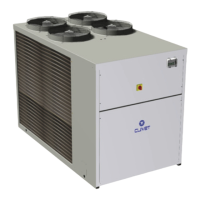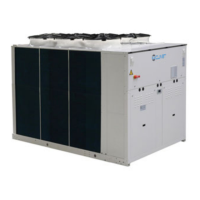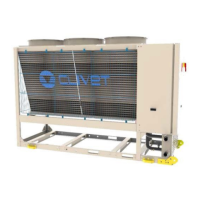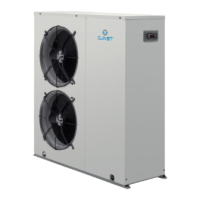Do you have a question about the CLIVET WSAN-XEE 182 and is the answer not in the manual?
Explains the serial number's role in unit identification and spare parts ordering.
Details the cooling (SUMMER) and heating (WINTER) cycles of the air-to-water heat pump.
Overview of manual purpose, instructions, expert requirements, installation, power, packaging, and maintenance.
Specific precautions to prevent risks to persons and health hazards during unit operation.
Identifies danger areas and risks associated with improper unit handling and installation.
Covers risks from burning smells, contact with components, unskilled repairs, and panel security.
Details hazards related to power supply, wiring, grounding, and live parts.
Risks from fan contact and refrigerant leaks/explosion, including safety datasheet reference.
Safety information for R-410A refrigerant, including handling, first aid, and properties.
Procedures for checking unit integrity upon delivery and reporting damage.
Technical spaces, thermal carrier fluid connections, and electrical connections for installation.
Anchoring, windbreaks, condensation water management, and avoiding environmental obstructions.
Installation of filters, flow switches, and measures to prevent freezing with glycol or heaters.
Handling condensation water during winter operation to prevent freezing and icing.
Requirements for qualified personnel, conformity, electrical data table, and mains connection.
Adjusting set points based on external temperature or enthalpy for energy efficiency.
Description of the local keypad, remote keypad, main adjustment, and expansion plug-in modules.
Essential checks before start-up, including unit installation, power, and system integrity.
Verifying refrigerant, water system, electrical connections, and crankcase heaters.
Checking water flow rate, pressure drops, and monitoring key refrigerant circuit parameters.
How to switch the unit ON/OFF and change between COOLING, HEATING, and ECO modes.
Explains outlet temperature control, head step, and scan time logic for resource activation.
Modifying set points dynamically based on external factors like temperature/enthalpy for efficiency.
Adjusting set points to extend operating limits, especially in heating mode based on external temperature.
How the unit prevents external coil ice build-up during winter operation using periodic switching.
Guidelines for identifying, eliminating, and resetting alarms to prevent damage.
Explains the serial number's role in unit identification and spare parts ordering.
Details the cooling (SUMMER) and heating (WINTER) cycles of the air-to-water heat pump.
Overview of manual purpose, instructions, expert requirements, installation, power, packaging, and maintenance.
Specific precautions to prevent risks to persons and health hazards during unit operation.
Identifies danger areas and risks associated with improper unit handling and installation.
Covers risks from burning smells, contact with components, unskilled repairs, and panel security.
Details hazards related to power supply, wiring, grounding, and live parts.
Risks from fan contact and refrigerant leaks/explosion, including safety datasheet reference.
Safety information for R-410A refrigerant, including handling, first aid, and properties.
Procedures for checking unit integrity upon delivery and reporting damage.
Technical spaces, thermal carrier fluid connections, and electrical connections for installation.
Anchoring, windbreaks, condensation water management, and avoiding environmental obstructions.
Installation of filters, flow switches, and measures to prevent freezing with glycol or heaters.
Handling condensation water during winter operation to prevent freezing and icing.
Requirements for qualified personnel, conformity, electrical data table, and mains connection.
Adjusting set points based on external temperature or enthalpy for energy efficiency.
Description of the local keypad, remote keypad, main adjustment, and expansion plug-in modules.
Essential checks before start-up, including unit installation, power, and system integrity.
Verifying refrigerant, water system, electrical connections, and crankcase heaters.
Checking water flow rate, pressure drops, and monitoring key refrigerant circuit parameters.
How to switch the unit ON/OFF and change between COOLING, HEATING, and ECO modes.
Explains outlet temperature control, head step, and scan time logic for resource activation.
Modifying set points dynamically based on external factors like temperature/enthalpy for efficiency.
Adjusting set points to extend operating limits, especially in heating mode based on external temperature.
How the unit prevents external coil ice build-up during winter operation using periodic switching.
Guidelines for identifying, eliminating, and resetting alarms to prevent damage.











